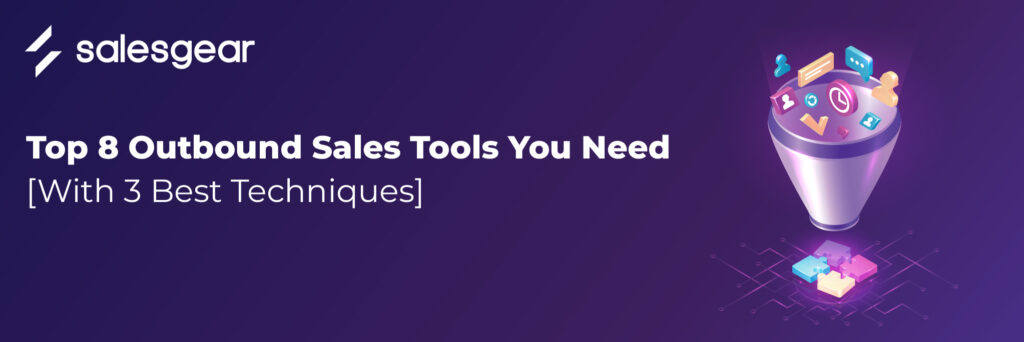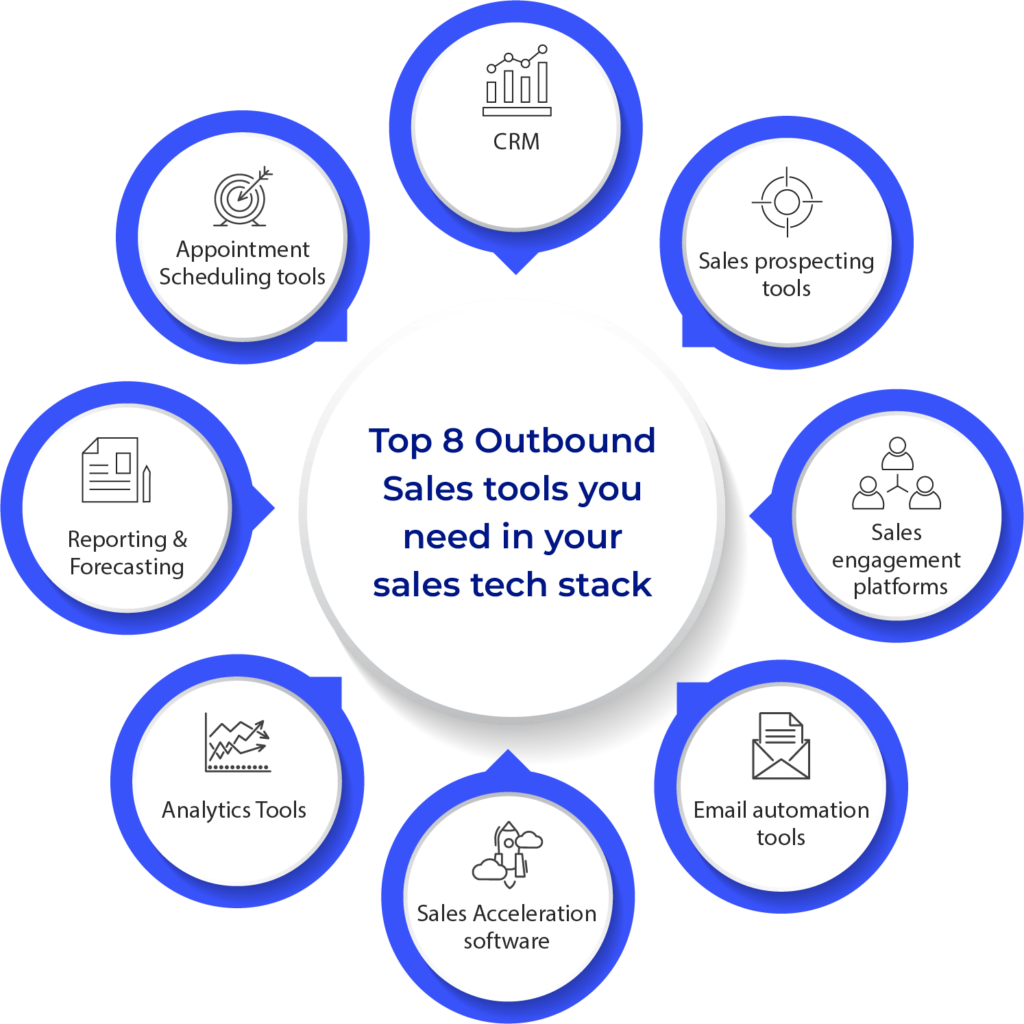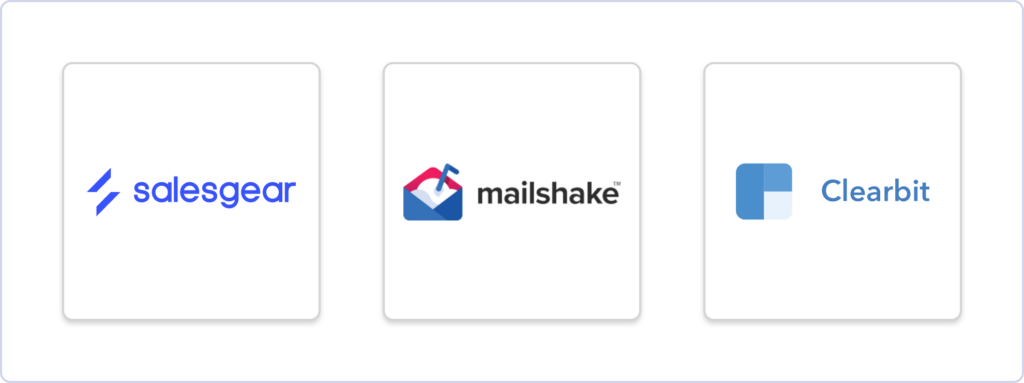
As a founder, chances are that you must be upset with how your SDRs are tired of waiting to hear back from prospects despite multiple follow-ups. If so, then it’s time to leverage technology to level up your sales game. For that, let’s understand an essential component of a sales strategy – the outbound sales tools.
The first step of an outbound sales process is to identify and define the ideal customer profile (ICP) very clearly. Once that’s done, the next step is to find the right prospects. To help with this, it’s crucial to have tools.
Table of contents
- What are Outbound Sales Tools?
- Why are they important?
- Top 8 Outbound Sales Tools you need in your sales tech stack
What are Outbound sales tools?
Now that we know that you’ve to buy the tools, the next obvious question is which tool to buy. Before that, you need to understand what these tools are and what exactly they do.
An outbound sales tool is the tech that you employ to identify, communicate, educate, engage, convince, and convert potential prospects. With these tools, your everyday life becomes much easier. But, how?
Why are they important?
Improve productivity
According to a report by Forbes, an average SDR spends about 65 percent of his/her time on other tasks than selling. This means for revenue of $100, a B2B SaaS firm spends $65 on non-revenue generating activities per rep. This is where the tools come in. They can help in automating these non-revenue activities and help you focus on what you must do- selling.

Personalization at Scale
Reaching out to prospects with personalized messages can be a challenge if it’s done manually. With the help of these outbound sales tools, you can automate most of the activities (as mentioned above). Hence, automation enables you to scale personalized outreach.
Qualified lead generation
Outbound sales tools, according to 85% of top sales leaders, are essential for attaining sales growth within their company.

This is because they help the sales teams with generating qualified leads that are relevant to the business. This means you can focus on high-quality prospects rather than irrelevant ones.
Top 8 Outbound Sales tools you need in your sales tech stack

Here’s the thing, you don’t need 1000 tools to start with the outbound sales. A well-thought-out sales strategy with few essential tools is good enough.
A sales tech stack is the collection of all your outbound sales tools. Let’s look at all the tools that you must have in your stack.
CRM Software
These are solutions that help companies manage their customer relationships and interactions throughout the customer lifecycle. Utilizing CRM software offers numerous advantages, one of which is the capacity to simplify and automate various sales procedures.
This can enhance efficiency and productivity, resulting in time and cost savings, and decreasing the possibility of human errors. Moreover, CRM software can facilitate businesses in comprehending their customers more effectively, providing them with valuable insights into customer behavior and preferences.
Examples- Salesforce, Pipedrive, Zoho, HubSpot, etc.

Sales Prospecting tools (Lead generation tools)
A sales prospecting tool refers to software employed by sales personnel to carry out research, identify, evaluate, and initiate initial contact with potential customers. These tools were initially developed to address a significant challenge for sales personnel – the scarcity of information required to engage decision-makers and deliver a pitch.
Such information includes factors such as company size, industry, revenue, job roles, personality, work-life, and others. The absence of adequate tools makes it extremely difficult for you to promptly obtain the contact information of the right decision-maker. This impacts the power to make informed decisions regarding lead qualification.
Examples- Salesgear, LinkedIn Sales Navigator, Lusha, Outreach, Zoominfo, etc.

Sales Engagement Platforms
Sales teams have, until now, faced a difficult decision between personalizing their emails or scaling their efforts. Personalization requires a significant investment of time, limiting the number of prospects that can be engaged in a day.
On the other hand, scaling up outreach involves increasing the volume of activity, which can result in sending the same generic message to every prospect, leading to fatigue for both reps and prospects.
However, with the advent of Sales Engagement Platforms, it is possible to strike a balance between the two approaches, allowing for both personalization and scalability in outreach efforts.
Examples- Salesgear, Mailshake, Clearbit, etc.

Email Automation tools
If you love numbers, you should know that most salespeople stop after sending one email (almost 70%). However, you’ve got a 25% chance of hearing back if you send more emails. (YesWare)

Email automation tools are the solutions that enable you to automate the process of sending personalized emails at scale. These tools simplify the process of setting up automated emails that are tailored to the right audience and delivered at the appropriate time.
Whether you own a large or small online business or possess any type of email list, you are likely to find a suitable tool to cater to your requirements from the options presented.
Example- Mailchimp, Sendgrid, Sendinblue, Mailerlite, etc.

Sales Acceleration Software
By automating repetitive operations and streamlining the sales process, sales acceleration software gives sales teams the tools and resources they need to engage with prospects and customers successfully.
However, these tools are made to accelerate the entire sales process with features like
- Real-time analytics,
- Lead prioritization, and
- Engagement tracking,
The difference between these tools and sales automation software is that the latter concentrates on automating manual tasks within the sales cycle, such as data entry, email follow-up, and lead tracking.
Whereas, sales acceleration software helps shorten the sales cycle.
Examples- Clari, Nimble, SalesLoft, Yesware, Groove, etc.

Sales Analytics and Reporting tools
Sending emails at the size of prospecting produces an unending flood of metrics, regardless of whether you employ all these tools or perform a campaign with fewer resources.
You can keep tabs and interpret your data using analytical tools. They not only compile, organize, and visualize the data, but they also utilize AI to transform it into useful intelligence.
These tools make doing the math less stressful and let you make decisions before gathering information.
Examples- Zoho Analytics, HubSpot sales hub, meetrecord, Alteryx, etc.
Sales Forecasting tools
These tools help companies in forecasting future sales performance using trends and data from the past. Businesses can decide on their sales tactics and budget allocation after receiving useful information about future sales outcomes.
Sales forecasting software helps companies keep on top of their sales targets and modify their tactics as necessary since it can track and analyze sales success in real time.
With the help of these tools, you can answer some of the questions like-
- How did real sales do against projections?
- What kept us from achieving our sales targets?
- Which projects should you invest in now that have a better chance of closing?
- How much money can we anticipate making this quarter?
- Which approach should we choose moving forward for the most precise sales forecasting?
Examples- Gong, InsightSquared, Aviso Insights, etc.
Appointment Scheduling tools
Your sales representatives must schedule many meetings each day to hit their quota, right? But is it still operating as effectively as it ought to? After all, there is a possibility that they could mistakenly miss some crucial schedules.
There are numerous outbound sales tools for scheduling meetings. They make meeting scheduling simple. Your potential customers will make their availability known and ask to meet when it is most convenient for them.
The scheduling platform will schedule the meeting and add it to your calendars automatically. That might not appear to be a significant issue. Yet when you schedule a large number of meetings a day, the valuable time spent scheduling meetings adds up. Your sales team can use the time for work that is more fruitful. Hence, you need to add these to your tech stack.
Examples- Calendly, Appointy, Simplybook.me, etc.
Best Outbound Sales Techniques
The goal of outbound sales activities is to focus on building relationships with potential customers. Without taking into account their needs, interests, or circumstances, forcing unsuspecting people into a sales presentation is a surefire way to fail.
Use techniques that will help foster healthy relationships with your prospects. Let’s dive into some of the best techniques that you can use for prospecting.
#1 Plan your Email Outreach
Setting up an email outreach strategy can be incredibly helpful for your sales teams for many reasons, like-
- Reach a wider audience without making phone calls or attending in-person meetings
- Personalize communication to cater to the needs and interests of specific individuals or companies
- Increase efficiency by automating the communication process with templates, automated follow-ups, and scheduled emails
- Better tracking and measurement of campaign effectiveness through tracking and reporting tools
- Identify what works and what needs improvement to refine the approach and achieve better results over time.
Have a list of targets, personalize the emails, and leverage an email automation tool for your outreach efforts. Planning is crucial to avoid any gaps in the strategy.
Suggested Read: Book 5 meetings a day with this cold email checklist
Pro tip
You must have high-quality leads for whom you can set up your strategy. So, use the outbound sales tools mentioned above to get those leads and then set up the strategy.
#2 Social Selling
‘Social selling’ is quickly becoming popular among sales teams, nowadays. It happens when SDRs communicate with prospects directly on social media. It’s also one of the best techniques to generate high-quality leads for your business.
It refers to the process of using social media platforms like LinkedIn, Twitter, and Facebook to identify, engage, and connect with prospects. Social selling tools like- Nimble, Sprout Social, etc. help businesses leverage social media platforms to identify potential customers and engage with them in a more personalized way.
Look at the following stats-
- Salespeople who utilize social media hit their quotas 66% more often than those who don’t use social media. (Source: Sales Benchmark Index)
- 96% of consumers desire more contact with industry leaders, with Twitter being a popular medium for engagement. (Source: Databox)
- Buyers who use social media generally have 84% larger budgets than non-social users. (Source: Social Buying Meets Social Selling)
- 90% of top-performing salespeople incorporate social media into their sales strategy. (Source: State of Sales)

These stats, and many more, underline the impact of social media in the buying process of a B2B SaaS tool. So, if your SDRs aren’t present on the social channels, where your prospects might be, you’re setting yourself up for failure.
Pro Tip
Engage with your audience on social media by dedicating up to an hour a day to commenting on posts, providing solutions, and offering helpful feedback.
#3 Cold Calling
Cold calling remains one of the most prominent methods to build up your sales pipeline. It involves initiating a conversation with someone unfamiliar with your business, which can be a simple yet effective way to get the ball rolling.
Cold calling is a fast and cost-effective way to move your sales process forward, even though you may face several rejections in a single day.
- Warm up your cold call– Research thoroughly about the prospects. Turn toward their social profiles and note down relevant details. Make the conversation about them, not about you.
- Ask questions– Start asking them about their issues as both parties become comfortable with each other. Explain to them how you handled a comparable issue with a different customer in the past. This will influence the conversation in a favorable direction.
- Explain the solution- the point of this call is to let them know about your product, right? So, make it clear how your solution will help them.
Suggested Read: The winning script for the first cold call
Takeaways
Sales prospecting is a crucial aspect of a thriving sales strategy, and there are numerous tools accessible to assist sales teams in generating leads, evaluating prospects, and finalizing deals.
- Outbound sales tools are essential for identifying, communicating, educating, engaging, convincing, and converting potential prospects.
- They improve productivity by automating non-revenue activities, allowing sales reps to focus on selling.
- Automation enables sales reps to scale personalized outreach and generate qualified leads that are relevant to the business.
- The essential tools that every company should have in its sales tech stack are CRM software, sales prospecting tools (lead generation tools), sales engagement platforms, email automation tools, and sales acceleration software.
- Key techniques to make your outbound prospecting efficient are planning an effective email outreach strategy, social selling, and cold calling.